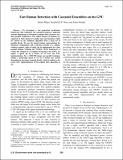Fast Human Detection With Cascaded Ensembles On The GPU
Author(s)
Bilgic, Berkin; Horn, Berthold Klaus Paul; Masaki, Ichiro
DownloadHorn_Fast human.pdf (1003.Kb)
PUBLISHER_POLICY
Publisher Policy
Article is made available in accordance with the publisher's policy and may be subject to US copyright law. Please refer to the publisher's site for terms of use.
Terms of use
Metadata
Show full item recordAbstract
We investigate a fast pedestrian localization framework that integrates the cascade-of-rejectors approach with the Histograms of Oriented Gradients (HoG) features on a data parallel architecture. The salient features of humans are captured by HoG blocks of variable sizes and locations which are chosen by the AdaBoost algorithm from a large set of possible blocks. We use the integral image representation for histogram computation and a rejection cascade in a sliding-windows manner, both of which can be implemented in a data parallel fashion. Utilizing the NVIDIA CUDA framework to realize this method on a Graphics Processing Unit (GPU), we report a speed up by a factor of 13 over our CPU implementation. For a 1280×960 image our parallel technique attains a processing speed of 2.5 to 8 frames per second depending on the image scanning density, which is similar to the recent GPU implementation of the original HoG algorithm in.
Date issued
2010-08Department
Massachusetts Institute of Technology. Computer Science and Artificial Intelligence Laboratory; Massachusetts Institute of Technology. Department of Electrical Engineering and Computer ScienceJournal
2010 IEEE Intelligent Vehicles Symposium (IV)
Publisher
Institute of Electrical and Electronics Engineers (IEEE)
Citation
Bilgic, Berkin, Berthold K.P. Horn, and Ichiro Masaki. “Fast Human Detection with Cascaded Ensembles on the GPU.” IEEE, 2010. 325–332. © Copyright 2010 IEEE
Version: Final published version
ISBN
978-1-4244-7866-8
ISSN
1931-0587